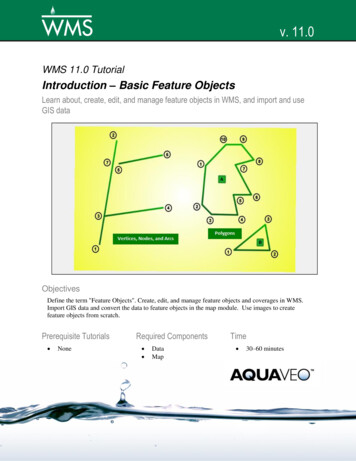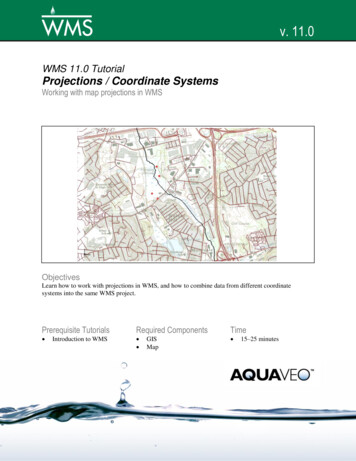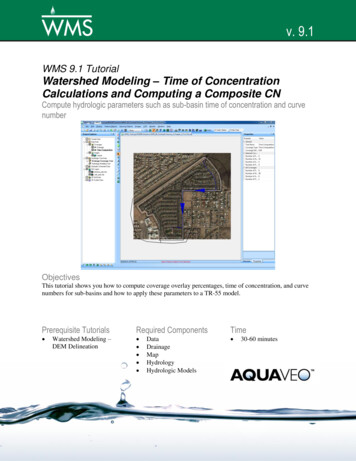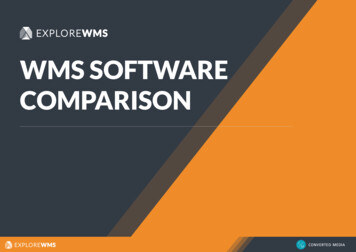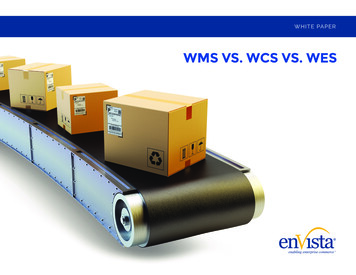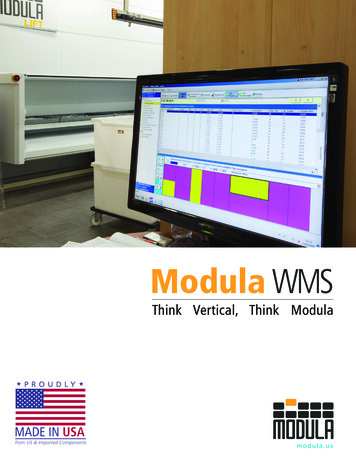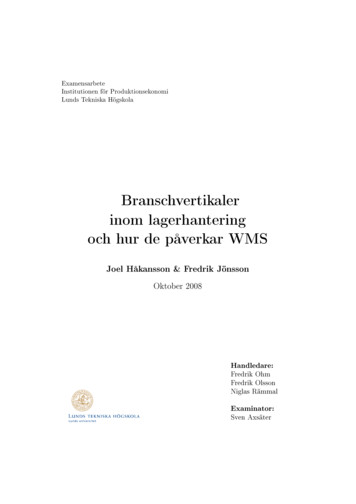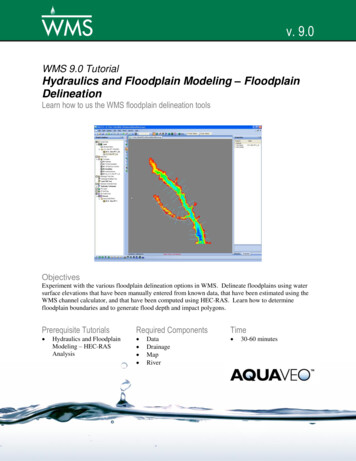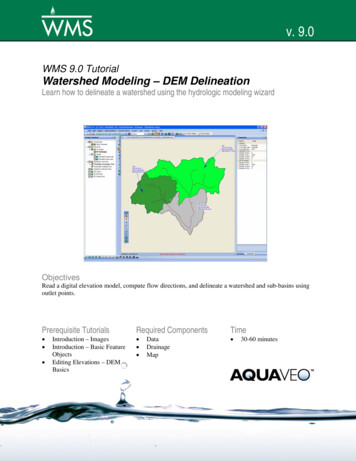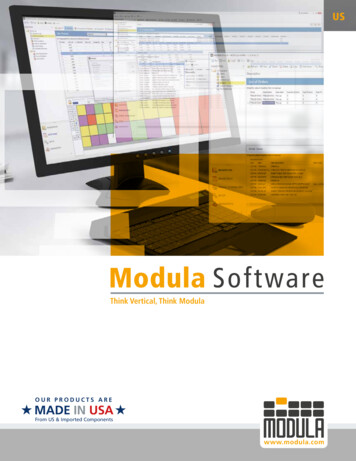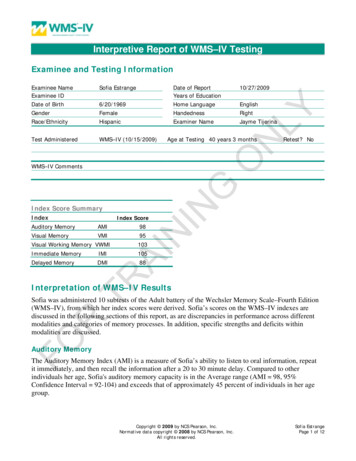
Transcription
Interpretive Report of WMS–IV TestingExaminee and Testing InformationDate of ReportYears of EducationHome LanguageHandednessExaminer Name6/20/1969FemaleHispanicTest AdministeredWMS–IV (10/15/2009)10/27/2009EnglishRightJayme TijerinaNLYSofia EstrangeAge at Testing 40 years 3 monthsRetest? NoOExaminee NameExaminee IDDate of BirthGenderRace/EthnicityIndex Score SummaryIndexIndex ScoreAMIVisual MemoryVMI98NAuditory MemoryINGWMS–IV Comments95103Immediate MemoryIMI105Delayed MemoryDMI88TRAIVisual Working Memory VWMIInterpretation of WMS–IV ResultsFORSofia was administered 10 subtests of the Adult battery of the Wechsler Memory Scale–Fourth Edition(WMS–IV), from which her index scores were derived. Sofia’s scores on the WMS–IV indexes arediscussed in the following sections of this report, as are discrepancies in performance across differentmodalities and categories of memory processes. In addition, specific strengths and deficits withinmodalities are discussed.Auditory MemoryThe Auditory Memory Index (AMI) is a measure of Sofia’s ability to listen to oral information, repeatit immediately, and then recall the information after a 20 to 30 minute delay. Compared to otherindividuals her age, Sofia's auditory memory capacity is in the Average range (AMI 98, 95%Confidence Interval 92-104) and exceeds that of approximately 45 percent of individuals in her agegroup.Copyright 2009 by NCS Pearson, Inc.Normative data copyright 2008 by NCS Pearson, Inc.All rights reserved.Sofia EstrangePage 1 of 12
NLYThe interpretation of Sofia’s AMI score should account for the significant inconsistency inperformance on specific measures within this domain. A closer look at these subtests is warranted.Within auditory memory, Sofia exhibited a strength on the Logical Memory I subtest. At the sametime, she displayed a weakness on the Verbal Paired Associates II subtest. Logical Memory I requiredSofia to recall specific details of information presented orally in a story format after only a singleexposure. This subtest measures the ability to recall verbal information that is conceptually organizedand semantically related immediately after hearing it (Logical Memory I scaled score 13). On VerbalPaired Associates II, Sofia was required to recall novel and semantically related word pairs after a 20to 30 minute delay. This subtest provides a measure of delayed cued recall for word associations(Verbal Paired Associates II scaled score 7).Visual MemoryGOOn the Visual Memory Index (VMI), a measure of memory for visual details and spatial location,Sofia performed in the Average range (VMI 95, 95% Confidence Interval 90-101). Sofia's visualmemory capacity exceeds that of approximately 37 percent of individuals in her age group.NINThe interpretation of Sofia’s VMI score should account for the significant inconsistency inperformance on a measure within this domain. A closer look at this subtest is warranted. Within visualmemory, Sofia exhibited a strength on the Visual Reproduction I subtest.On Visual Reproduction I Sofia was required to view a series of designs and to draw each one frommemory immediately after seeing it. This subtest measures recall for visual information, including thedetails and relative spatial relationship among elements of a drawing (Visual Reproduction I scaledscore 12).TRAIModality-Specific Memory Strengths and WeaknessesSome individuals are better at recalling visual information than recalling auditory information, whilefor others the reverse is true. Compared to individuals with similar auditory memory capacity, Sofia’svisual memory performance is in the Average range (37th percentile), indicating no significantdifference between her levels of visual and auditory memory functioning.Visual Working MemoryFOROn the Visual Working Memory Index (VWMI), a measure of her ability to temporarily hold andmanipulate spatial locations and visual details, Sofia performed in the Average range (VWMI 103,95% Confidence Interval 96-110). Sofia’s visual working memory ability exceeds that ofapproximately 58 percent of individuals in her age group.Sofia’s performance on the Spatial Addition subtest was significantly better than her performance onthe Symbol Span subtest, suggesting that her profile of memory functioning within visual workingmemory exhibits significant variability. Therefore, a closer look at these two subtests is warranted. OnSpatial Addition, Sofia was shown patterns of blue and red circles on two grids presentedconsecutively. She was then required to place cards with different colored circles in a grid accordingto a set of rules, based on the grids that she had been shown. This subtest measures spatial workingmemory and requires storage, manipulation, and the ability to ignore competing stimuli (SpatialCopyright 2009 by NCS Pearson, Inc.Normative data copyright 2008 by NCS Pearson, Inc.All rights reserved.Sofia EstrangePage 2 of 12
Addition scaled score 12). Symbol Span required Sofia to identify a series of novel symbols, inorder from left to right, immediately after seeing the symbols in their correct order. This subtestmeasures the capacity to keep a mental image of a symbol and its relative spatial position on the pagein mind (Symbol Span scaled score 9).NLYSpecificity of Episodic Visual Memory Abilities Compared to Visual WorkingMemory AbilitiesOComparing episodic visual memory to visual working memory performance can help determine therelative influence of visual memory on visual working memory (e.g., to determine if a low VMI scoreis due to deficits in visual working memory or to episodic visual memory deficits). Compared toindividuals with similar visual working memory capacity, Sofia’s visual memory performance is in theAverage range (25th percentile), indicating no significant difference between her levels of visualmemory and visual working memory functioning.Immediate and Delayed MemoryTRAININGThe Immediate Memory Index (IMI) is a measure of Sofia’s ability to recall verbal and visualinformation immediately after the stimuli is presented. Compared to other individuals her age, Sofia'simmediate memory capacity is in the Average range (IMI 105, 95% Confidence Interval 99-111)and exceeds that of approximately 63 percent of individuals in her age group. On the Delayed MemoryIndex (DMI), a measure of the ability to recall verbal and visual information after a 20 to 30 minutedelay, Sofia performed in the Low Average range (DMI 88, 95% Confidence Interval 82-95).Sofia's delayed memory capacity exceeds that of approximately 21 percent of individuals in her agegroup.The interpretation of Sofia’s IMI score should account for the significant inconsistency in performanceon a measure within this domain. A closer look at this subtest is warranted. Within immediatememory, Sofia displayed a relative weakness on the Verbal Paired Associates I subtest. Verbal PairedAssociates I required Sofia to recall novel and semantically related word pairs. This subtest measuresimmediate learning of verbal associations over multiple exposures (Verbal Paired Associates I scaledscore 8).FORThe interpretation of Sofia’s DMI score should account for the significant inconsistency inperformance on a measure within this domain. A closer look at this subtest is warranted. Withindelayed memory, Sofia exhibited a relative strength on the Logical Memory II subtest. On LogicalMemory II, Sofia was asked to recall specific details of information presented orally in a story formatin a single exposure. This subtest measures the ability to recall verbal information that is conceptuallyorganized and semantically related after a delay (Logical Memory II scaled score 11).Retention of InformationSome individuals lose information between immediate and delayed recall, while others actuallyimprove their memory performance over time. The overall amount of forgetting and consolidation thatoccurred between the immediate and delayed tasks is indicated by the level of Sofia’s delayed memoryperformance given her immediate memory performance. Compared to individuals with a similar levelCopyright 2009 by NCS Pearson, Inc.Normative data copyright 2008 by NCS Pearson, Inc.All rights reserved.Sofia EstrangePage 3 of 12
of immediate memory capacity, Sofia’s delayed memory performance is in the Extremely Low range(1st percentile), indicating that her delayed memory is much lower than expected, given her level ofinitial encoding.Specific Auditory Memory AbilitiesNLYAuditory Process ScoresOOn a measure of her ability to answer specific questions about details from a previously heard story,Sofia performed in the average range (LM II Recognition cumulative percentage 26-50%). Sofiaperformed in the borderline range on a measure of her ability to identify previously presented wordassociations (VPA II Recognition cumulative percentage 3-9%). When asked to recall as manywords as she could remember from a previously presented list of word pairs, without being required tocorrectly associate the words, Sofia performed in the average range (VPA II Word Recall scaled score 10).Auditory Forgetting and Retrieval ScoresTRAININGThe degree to which Sofia may benefit from story details being presented in a recognition formatinstead of a free recall format can be determined by comparing her delayed cued recall performance tothat of individuals with a similar level of recognition memory (LM II Recognition vs. Delayed Recallcontrast scaled score 12). This comparison suggests that Sofia is able to retrieve auditoryinformation from memory as well as expected, given her level of recognition memory. The degree towhich Sofia forgot the story details she learned during the immediate condition of Logical Memory Ican be determined by comparing her delayed recall performance to that of others with a similar levelof immediate recall (LM II Immediate Recall vs. Delayed Recall contrast scaled score 7). Thiscomparison indicates that Sofia displayed a higher than expected rate of forgetting, given herimmediate memory performance.FORThe degree to which Sofia may benefit from word associations being presented in recognition formatversus cued recall can be determined by comparing her delayed cued recall performance to that ofindividuals with a similar level of recognition memory (VPA II Recognition vs. Delayed Recallcontrast scaled score 11). Based on this comparison, Sofia is able to retrieve auditory informationfrom memory as well as expected, given her level of recognition memory. The degree to which Sofiaforgot the word associations she learned during immediate recall of Verbal Paired Associates I can bedetermined by comparing her delayed recall performance to that of others with a similar level ofimmediate recall (VPA II Immediate Recall vs. Delayed Recall contrast scaled score 8). Thiscomparison indicates that Sofia is able to recall cued word associations after a delay as well asexpected, given her level of immediate recall.Specific Visual Memory AbilitiesVisual Process ScoresSofia’s immediate memory for visual details is in the average range, while her delayed memory forvisual details is below average (DE I Content scaled score 8, DE II Content scaled score 7).Although she is not likely to have difficulty recalling specific visual information soon after it ispresented when compared to individuals her age, her ability to recall the information decreases overCopyright 2009 by NCS Pearson, Inc.Normative data copyright 2008 by NCS Pearson, Inc.All rights reserved.Sofia EstrangePage 4 of 12
NLYtime more than is typical. When required to recall designs and their locations in a grid, Sofia’simmediate and delayed memory for the locations of cards placed in the grid, regardless of her abilityto recall the visual details of the cards, are both in the average range, indicating that she is not likely tohave difficulty recalling spatial locations when compared to individuals her age (DE I Spatial scaledscore 10, DE II Spatial scaled score 8). On a measure of her ability to recognize designspreviously presented and the correct locations for the designs, Sofia performed in the borderline rangewhen compared to others her age (DE II Recognition cumulative percentage 3-9%).On a measure of Sofia’s ability to discriminate designs she saw previously from similar designs thatwere not shown, she performed in the low average range when compared to others her age (VR IIRecognition cumulative percentage 10-16%). When required to simply copy designs as she lookedat them, Sofia was able to perform the task as well as or better than 26-50% percent of individuals herage.OVisual Forgetting and Retrieval ScoresTRAININGSofia’s immediate recall of visual details is average when compared to others with similar levels ofimmediate spatial memory ability. Her delayed recall of visual details is average when compared toothers with similar levels of delayed spatial memory ability. Sofia’s level of free recall for visualdetails and spatial locations relative to her recognition memory for this visual information can bedetermined by comparing her delayed recall performance to that of individuals with a similar level ofrecognition memory (DE II Recognition vs. Delayed Recall contrast scaled score 11). Thiscomparison indicates that she is able to freely recall visual information as well as expected, given herlevel of recognition memory. The degree to which Sofia forgot the visual details and spatial locationsshe learned during the immediate condition of the Designs subtest can be determined by comparingher delayed recall performance to that of individuals with a similar level of immediate memory (DEImmediate Recall vs. Delayed Recall contrast scaled score 6). Based on this comparison, Sofiadisplayed a higher than expected rate of forgetting, given her immediate memory performance.FORIt is possible to determine the degree to which Sofia’s ability to recall the details and relative spatialrelationships among elements of a design benefits from the designs being presented in a recognitionformat instead of a free recall format by comparing her ability to draw the designs after a delay to herability to discriminate the previously drawn designs from similar designs (VR II Recognition vs.Delayed Recall contrast scaled score 10). This comparison indicates that she is able to freely recalldetails and relative spatial relationships among elements in a design as well as expected, given herlevel of recognition memory. When compared to others with a similar level of simple copying ability,Sofia’s ability to immediately recall and draw the details and relative spatial relationships amongelements of a design is what would be expected given her level of copying ability (VR II Copy vs.Immediate Recall contrast scaled score 12). The degree to which Sofia forgot the details and relativespatial relationship among elements of the designs presented during the immediate recall of the VisualReproduction subtest can be determined by comparing her ability to recall and draw the designs after adelay to that of individuals with a similar level of immediate ability (VR Immediate Recall vs.Delayed Recall contrast scaled score 6). Based on this comparison, Sofia displayed a higher thanexpected rate of forgetting, given her immediate memory performance.Copyright 2009 by NCS Pearson, Inc.Normative data copyright 2008 by NCS Pearson, Inc.All rights reserved.Sofia EstrangePage 5 of 12
Test Results SummarySofia is a 40-year-old female who completed the WMS–IV.ONLYSofia was administered 10 subtests of the Adult battery of the WMS–IV. Sofia's ability to listen to oralinformation and repeat it immediately, and then recall the information after a 20 to 30 minute delay isin the Average range. Her memory for visual details and spatial location is in the Average range. Herability to temporarily hold and manipulate spatial locations and visual details is in the Average range.Sofia’s ability to recall verbal and visual information immediately after the stimuli is presented is inthe Average range. Her ability to recall verbal and visual information after a 20 to 30 minute delay isin the Low Average range. Sofia displayed a notable amount of forgetting between the immediate anddelayed tasks of the WMS–IV. Compared to individuals with a similar level of immediate memorycapacity, Sofia’s delayed memory performance is in the Extremely Low range, indicating that herdelayed memory is much lower than expected given her level of initial encoding.RecommendationsINGSofia may benefit from using associative linkages when encoding information. By linking newinformation to what has been previously learned, she may be able to gain a more global understandingof the information and improve recall.NWhen Sofia first encounters new information, she should link it in as many ways as possible to alreadyknown information. This strategy creates several avenues for remembering the information later.TRAISofia should be encouraged to use external memory sources such as lists, date books, calendars, andpocket-size recorders for information that must be remembered.Teaching Sofia “self-cueing” strategies may help facilitate her retrieval of information.RTests for Sofia should be structured so that they require recognition rather than recall of information.They should be structured in multiple choice or other selected-response formats, rather than inextended short-answer and essay. Test formats such as these will assist her in retrieving previouslylearned information.FOSofia should be encouraged to use a “memory book” that would include information such as her dailyschedule; important names, addresses, and phone numbers; personal information; medicationschedule; and due dates of monthly bills.This report is valid only if signed by a qualified professional:Copyright 2009 by NCS Pearson, Inc.Normative data copyright 2008 by NCS Pearson, Inc.All rights reserved.Sofia EstrangePage 6 of 12
Score ReportIndex Score SummaryAuditory MemoryVisual MemoryVisual Working MemoryImmediate MemoryDelayed Memory3937214333Index ScoreAMIVMIVWMIIMIDMI95%ConfidenceQualitative DescriptionPercentile 1099-11182-95AverageAverageAverageAverageLow AverageNLYIndexSum ofScaled ScoresIndex Scores andStandard Error ofMeasurementOIndex Score 353.67FORTRAININGIndexThe vertical bars represent the standard error of measurement (SEM).Copyright 2009 by NCS Pearson, Inc.Normative data copyright 2008 by NCS Pearson, Inc.All rights reserved.Sofia EstrangePage 7 of 12
Primary Subtest Scaled Score SummaryRaw ScoreScaled ScorePercentile 710712812984632516501675257537FORTRAININGOLogical Memory ILogical Memory IIVerbal Paired Associates IVerbal Paired Associates IIDesigns IDesigns IIVisual Reproduction IVisual Reproduction IISpatial AdditionSymbol SpanDomainNLYSubtestCopyright 2009 by NCS Pearson, Inc.Normative data copyright 2008 by NCS Pearson, Inc.All rights reserved.Sofia EstrangePage 8 of 12
TRAININGONLYPrimary Subtest Scaled Score ProfileProcess Score ConversionsAuditory Memory Process Score SummaryProcess ScoreScaled ScorePercentile RankCumulative Percentage(Base Rate)243318105026-50%3-9%-FORLM II RecognitionVPA II RecognitionVPA II Word RecallRaw ScoreCopyright 2009 by NCS Pearson, Inc.Normative data copyright 2008 by NCS Pearson, Inc.All rights reserved.Sofia EstrangePage 9 of 12
Visual Memory Process Score SummaryRaw ScoreScaled ScorePercentile RankCumulative Percentage(Base E I ContentDE I SpatialDE II ContentDE II SpatialDE II RecognitionVR II RecognitionVR II CopySubtest-Level Differences Within IndexesDifference from MeanCritical ValueBase 2.485% 25% 25%15%VMI MeanScoreDifference from MeanCritical ValueBase 1.48 25%15-25%15% 25%IMI MeanScoreDifference from MeanCritical ValueBase 2.421.91 25%15-25% 25% 25%NLogical Memory I13Logical Memory II11Verbal Paired Associates I8Verbal Paired Associates II7Statistical significance (critical value) at the .05 level.AMI MeanScoreTRAIVisual Memory IndexSubtestGScaled ScoreINSubtestOAuditory Memory IndexNLYProcess ScoreScaled ScoreDesigns I10Designs II7Visual Reproduction I12Visual Reproduction II8Statistical significance (critical value) at the .05 level.RImmediate Memory IndexFOSubtestScaled ScoreLogical Memory I13Verbal Paired Associates I8Designs I10Visual Reproduction I12Statistical significance (critical value) at the .05 level.Copyright 2009 by NCS Pearson, Inc.Normative data copyright 2008 by NCS Pearson, Inc.All rights reserved.Sofia EstrangePage 10 of 12
Delayed Memory IndexScaled ScoreLogical Memory II11Verbal Paired Associates II7Designs II7Visual Reproduction II8Statistical significance (critical value) at the .05 level.DMI MeanScoreDifference from MeanCritical ValueBase 41.5715-25% 25% 25% 25%Subtest Discrepancy ComparisonScore 1Score 2129Subtest-Level Contrast Scaled ScoresScoreRI Spatial vs. ContentII Spatial vs. ContentII Recognition vs. Delayed RecallImmediate Recall vs. Delayed RecallFODEDEDEDEContrast Scaled Score1111127Score 2Contrast Scaled Score3-9%877118Score 1Score 2Contrast Scaled Score1083-9%10877788116Score 1Score 2Contrast Scaled Score10-16%26-50%12812810126Score 1VPA II Recognition vs. Delayed RecallVPA Immediate Recall vs. Delayed RecallDesignsScore 2TRAIScore41.8Score 1NVerbal Paired AssociatesBase Rate2.7426-50%13INScoreLM II Recognition vs. Delayed RecallLM Immediate Recall vs. Delayed Recall3GLogical MemoryDifference Critical ValueOComparisonSpatial Addition – Symbol SpanStatistical significance (critical value) at the .05 level.NLYSubtestVisual ReproductionScoreVR II Recognition vs. Delayed RecallVR Copy vs. Immediate RecallVR Immediate Recall vs. Delayed RecallCopyright 2009 by NCS Pearson, Inc.Normative data copyright 2008 by NCS Pearson, Inc.All rights reserved.Sofia EstrangePage 11 of 12
Index-Level Contrast Scaled ScoresWMS–IV IndexesScoreScore 2Contrast Scaled Score98103105959588983FORTRAININGONLYAuditory Memory Index vs. Visual Memory IndexVisual Working Memory Index vs. Visual Memory IndexImmediate Memory Index vs. Delayed Memory IndexScore 1Copyright 2009 by NCS Pearson, Inc.Normative data copyright 2008 by NCS Pearson, Inc.All rights reserved.Sofia EstrangePage 12 of 12
relative influence of visual memory on visual working memory (e.g., to determine if a low VMI score is due to deficits in visual working memory or to episodic visual memory deficits). Compared to individuals with similar visual working memory capacity, Sofia's visual memory performance is in the
